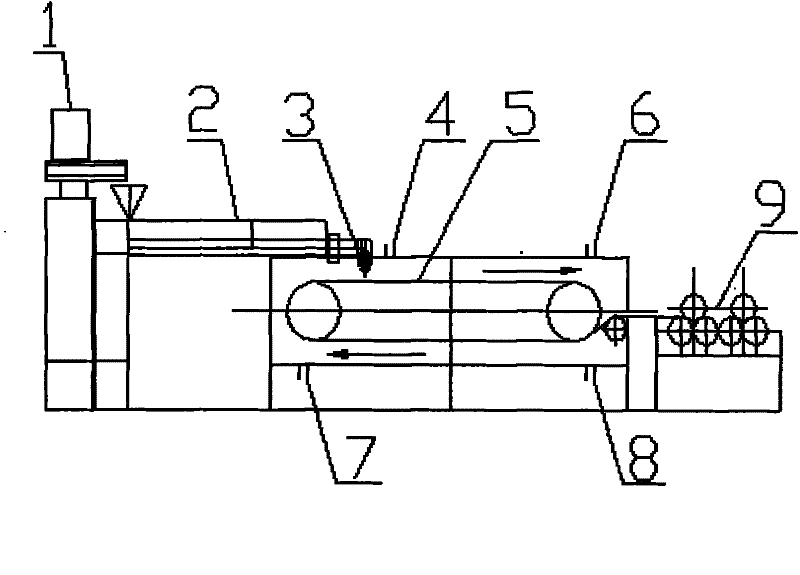Polyvinylidene fluoride microporous film prepared through gelatin extrusion tape casting method
A polyvinylidene fluoride, extrusion casting technology, used in flat products, other household appliances, coatings, etc., can solve the problems of large solvent volatilization and low solid content, and achieve low solvent consumption and high solid content. , the effect of saving energy
- Summary
- Abstract
- Description
- Claims
- Application Information
AI Technical Summary
Problems solved by technology
Method used
Image
Examples
Embodiment 1
[0032] Add 2kg of N,N-dimethylacetamide (DMAC) into 10kg of PVDF, and stir at room temperature to form a uniform gel. Then the gel is added to the metering feeder (1) of the extruder, plasticized and melted in the screw extruder (2) at 200-215°C, and extruded through the die (3) at 80°C The film is cast on the steel belt (5) rotating at a uniform speed, and the steel belt speed is 3 revolutions / minute. After the continuously heated steel strip is dried, it is wound up by a winder (9) to form a film, and finally the finished microporous film is obtained. The thickness of the film is 20 μm, the thickness tolerance in the vertical and horizontal directions is less than 0.5 μm, the pore size of the micropore is 2-5 μm, the porosity is 43%, and the water flux under the pressure of 0.1MPa is 180L / m2·h.
Embodiment 2
[0034] Add 2kg of N,N-dimethylformamide (DMF) into 10kg of PVDF, and stir at room temperature to form a uniform gel. Then the gel is added to the metering feeder (1) of the extruder, plasticized and melted in the screw extruder (2) at 200-215°C, and extruded through the die (3) at 70°C The film is cast on the steel belt (5) rotating at a uniform speed, and the steel belt speed is 3 revolutions / minute. After the continuously heated steel strip is dried, it is wound up by a winder (9) to form a film, and finally the finished microporous film is obtained. The thickness of the film is 20 μm, the thickness tolerance in the vertical and horizontal directions is less than 0.5 μm, the pore diameter of the micropore is 2-5 μm, the porosity is 40%, and the water flux under the pressure of 0.1MPa is 175L / m2 h.
Embodiment 3
[0036] Add 2kg of N-methylpyrrolidone (NMP) into 10kg of PVDF, and stir at room temperature to form a uniform gel. Then add the gel into the metering feeder (1) of the extruder, plasticize and melt extrude in the screw extruder (2) at 200-215°C, pass through the die (3) at 100°C The film is cast on the steel belt (5) rotating at a uniform speed, and the steel belt speed is 3 revolutions / minute. After the continuously heated steel strip is dried, it is wound up by a winder (9) to form a film, and finally the finished microporous film is obtained. The thickness of the film is 20 μm, the thickness tolerance in the longitudinal and transverse directions is less than 0.5 μm, the micropore diameter is 2-5 μm, the porosity is 50%, and the water flux under the pressure of 0.1 MPa is 195 L / m2 h.
5. Description of drawings
[0037] The accompanying drawing of the description is a process flow chart of preparing polyvinylidene fluoride microporous membrane by gel extrusion casting met...
PUM
| Property | Measurement | Unit |
|---|---|---|
| Thickness | aaaaa | aaaaa |
| Pore diameter | aaaaa | aaaaa |
| Water flux | aaaaa | aaaaa |
Abstract
Description
Claims
Application Information
 Login to View More
Login to View More - R&D
- Intellectual Property
- Life Sciences
- Materials
- Tech Scout
- Unparalleled Data Quality
- Higher Quality Content
- 60% Fewer Hallucinations
Browse by: Latest US Patents, China's latest patents, Technical Efficacy Thesaurus, Application Domain, Technology Topic, Popular Technical Reports.
© 2025 PatSnap. All rights reserved.Legal|Privacy policy|Modern Slavery Act Transparency Statement|Sitemap|About US| Contact US: help@patsnap.com


